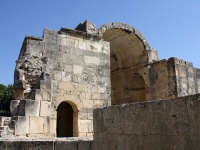
Gortyna is both a municipality in Greece and an archaeological site on Crete which was once the Roman capital of the island. The two are unrelated. The remains of the ancient city of Gortyna, to the south of Heraklion, tell a later tale than that of the other archaeological sites in Crete, despite the fact that there is evidence of human settlement in the area dating back to the Neolithic era. The greatest treasure of the site is the Gortyn Law Code, recorded on important inscribed stones which date back to the 5th century BC. These remarkable stones are a complete code of law based on Minoan tradition. The Code stones are still preserved and exhibited in the north round wall of the Roman Odeon at the Gortyna site (although of course the theatre was built much later, in the 1st century). Other highlights at Gortyna include the Church of St Titus, where Christianity was first introduced to the island, and the Temple of Apollo Pythios, which dates from 700 BC. The city was thriving before Roman invasion but its early alliance with the Romans meant that it was not invaded and became even more powerful in the region. The site is often called Gortyn, rather than Gortyna.
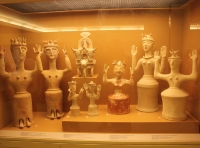
A visit to the Minoan palace at Knossos should be complemented with a visit to the wonderful Archaeological Museum in Heraklion. This is one of the largest and most renowned museums in Greece, and even in Europe, and the Minoan collection is the best of its kind in the world. The museum features artefacts spanning 5,500 years of Cretan history and prehistory from the Neolithic (5000 BC) to the Late Roman Period (late 4th century AD). Thousands of artefacts depicting the intriguing Minoan culture are on display, from magnificent bull-headed drinking vessels to the mysterious Phaistos disk inscribed with undeciphered symbols. The exhibition takes up 20 rooms and is arranged chronologically. There is a museum shop where visitors can buy copies, books, postcards and the like, and a museum cafe for refreshments.
Address : Xanthoudidou Street, just off Plateia Eleftherias
Website : www.heraklion-crete.org/archaeological-museum/
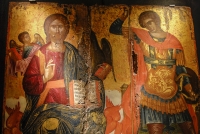
This museum deals with Crete's more modern history and highlights the islanders' long battle for independence from early Christian times to the present day. The museum is housed in a two-storey neoclassical building constructed in 1903 on the site of an earlier mansion. The Historical Museum has impressive collections of ceramics, sculptures, coins, jewellery, Byzantine art, Ottoman artefacts, and ethnographic displays, and the history of Crete is thoroughly and well laid out. The medieval and Renaissance collection contains the only painting on Crete by the island's famous painter El Greco, The Landscape of God-trodden Mount Sinai, which is one of the museum's treasures. Another world-renowned Cretan, Nikos Kazantzakis, author of Zorba the Greek, is also remembered in the museum, which houses a recreation of his study. There are frequent temporary exhibitions to be enjoyed and a library containing some interesting documents and rare editions which is open to the public.
Address : 7 Lysimahou Kalokerinou
Website : www.historical-museum.gr
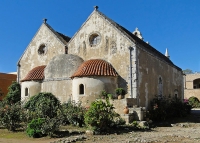
Situated about 14 miles (23km) south of Rethymnon, the Monastery of Arkádhi is something of a national Cretan shrine. During the 1866 rebellion against the Turks the monastery became a refuge for Cretan insurgents and their families (it was the Cretan Christians who revolted against Turkish rule in the rebellion). They were surrounded by the Turks and after two days of fighting, ignited the gunpowder storeroom, which killed hundreds of both Turks and Cretans. The tragedy brought international recognition to the cause for Cretan independence and those who died in the blast have become celebrated martyr figures. An ossuary displays the skulls of many of the victims and it is possible to see the roofless room where the explosion took place, as well as the surviving 16th-century church that is one of the loveliest Venetian buildings on the island. There is also a small museum which details the history of the monastery and the battle for independence. It is a very interesting, and rather sad, place to explore and gives visitors some valuable insight into Cretan nationalism and history.
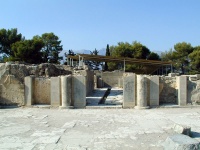
South of Heraklion lies Crete's second most important Minoan archaeological site, the Palace complex of Phaistos, considered by many to be a finer example of Minoan architecture than Knossos. The west propylon, the monumental entranceway to the palace, is particularly impressive, and the ceremonial staircase and great court are breathtaking. Like Knossos the site has actually been built on twice, with the original palace, built about 2000 BC, having been destroyed by fire and replaced with a new palace around 300 years later. A number of valuable artefacts have been found on the site including the Phaistos disc which was discovered in 1908 in the basements of the northern complex of the palace. This artefact is a clay disk, dated to between 1950 BC and 1400 BC and impressed with a unique and sophisticated hieroglyphic script. A number of tombs were also found, a short distance from the ruins of the palace complex, and these are thought to belong to the one-time rulers of Phaistos. The city of Phaistos is associated with the mythical king of Crete, Rhadamanthys, and the city is mentioned in many old texts including Homer, who detailed the city's involvement in the siege of Troy. For anybody with an interest in archaeology Phaistos is a must.
Address : 38 miles (61km) south of Heraklion
Website : www.ancient-greece.org/archaeology/phaistos.html
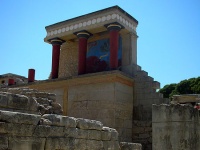
The Minoan palace at Knossos, covering an area of 215,278 square feet (20,000 sq metres), is one of the world's greatest sightseeing experiences and a must for visitors in the area. It consists of four wings, arranged around a rectangular, central court. The palace originally had many storeys, was built of ashlar blocks, and had walls decorated with splendid frescoes. British archaeologist, Arthur Evans, who excavated most of the labyrinthine Knossos site, has painstakingly restored some sections of the palace. The remains now visible are actually not those of the original palace, which was built around 2,000 BC and destroyed by an earthquake about 1,700 BC. A subsequent, more complex, palace was then constructed and it is these ruins which can still be seen and parts of which have been restored. The palace was first unearthed in 1878 by a Cretan merchant and antiquarian, but was not systematically excavated until 1900. The Knossos site is about three miles (5km) south of Heraklion.
Address : Knossos, 714 09
Website : www.ancient-greece.org/archaeology/knossos.html
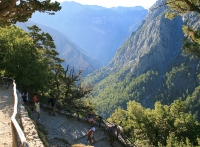
The Samaria Gorge National Park, in the White Mountains of western Crete, is said to be one of the most splendid scenic parks in Europe and the hike through the gorge is breathtaking. It is an arduous trip but well worth it to see one of the great natural wonders of Europe and most people will be able to handle the walk although they may find it strenuous. From the top of the gorge it is a 10 mile (16km) hike through the dramatic geological formations and wildflower-strewn cliff sides of the National Park. There are lots of awe-inspiring views and natural features along the way and it is a dream for photographers. Once inside the gorge hikers tend to follow the water, which helps keep one cool but hikers must note that they will be in direct sun at least part of the time so it is important to come prepared with hats, sunscreen and water. Hikers are always delighted to see that there are restaurants and bars at the end of the walk to provide well-earned refreshment. From the village of Agia Roumeli at the end of the gorge hikers board boats to sail to Khora Sfakion or Paleohora where there are buses back to Haniá, Rethymnon or Heraklion. Nature-lovers will find the gorge one of the absolute highlights of a visit to Crete.

01474 814411

Travel Guide powered by Word Travels, copyright © 2023 Globe Media Ltd. By its very nature information in this travel guide is subject to change at short notice and travellers are urged to verify information on which they're relying with the relevant authorities. Neither Globe Media Ltd nor Travel Vogue can accept any responsibility for any loss or inconvenience to any person as a result of information contained above.